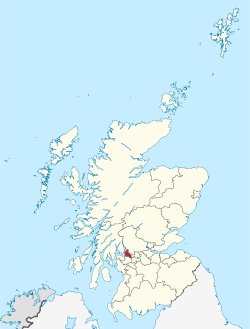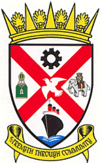West Dunbartonshire
| West Dunbartonshire Wast Dunbartanshire Siorrachd Dhùn Bhreatainn an Iar | ||
|---|---|---|
 | ||
| ||
| Coordinates: 55°59′24″N 4°30′54″W / 55.99000°N 4.51500°WCoordinates: 55°59′24″N 4°30′54″W / 55.99000°N 4.51500°W | ||
| Admin HQ | Dumbarton | |
| Government | ||
| • Body | West Dunbartonshire Council | |
| • Control | Labour | |
| • MPs | ||
| • MSPs | ||
| Area | ||
| • Total | 61 sq mi (159 km2) | |
| Area rank | Ranked 31st | |
| Population (2010 est.) | ||
| • Total | 91,000 | |
| • Rank | Ranked 22nd | |
| • Density | 1,500/sq mi (570/km2) | |
| ONS code | 00QG | |
| ISO 3166 code | GB-WDU | |
| Website | http://www.west-dunbarton.gov.uk/ | |
West Dunbartonshire (Scots: Wast Dunbartanshire; Scottish Gaelic: Siorrachd Dhùn Bhreatainn an Iar, pronounced [ʃirˠəxk ɣumˈpɾʲɛʰt̪ɪɲ ə ɲiəɾ]) is one of the 32 local government council areas of Scotland. The area lies to the west of the City of Glasgow and contains many of Glasgow's commuter towns and villages, as well as the city's suburbs. West Dunbartonshire also borders onto Argyll and Bute, East Dunbartonshire, Renfrewshire and Stirling.
The area was formed on 1 April 1996 from part of the former Strathclyde Region, namely the entire district of Clydebank and the Dumbarton district less the Helensburgh area. In the Local Government etc. (Scotland) Act 1994 that created the council area its name was Dumbarton and Clydebank. The council, elected as a shadow authority in 1995, resolved to change the name of the area to West Dunbartonshire.[1]
The area is essentially composed of three parts: the towns of Clydebank, Dumbarton and the Vale of Leven district.
West Dunbartonshire is administered from Dumbarton, although Clydebank is the largest town.
Governance and politics
The council is run by 22 councillors elected from 6 wards.[2] All Scottish local authorities were last elected in 2012; in West Dunbartonshire, the following parties were elected:[3]
The Labour Party regained control of the council from an SNP/independent coalition at the 2012 local election.
On 18 September 2014, West Dunbartonshire was one of four council areas which had a majority "Yes" vote in the Scottish Independence Referendum at 54% with a 87.9% turnout rate.[4]
Towns and villages
- Alexandria
- Balloch
- Bonhill
- Bowling
- Clydebank
- Dalmuir
- Drumry
- Dumbarton
- Duntocher
- Faifley
- Gartocharn
- Hardgate
- Jamestown
- Linnvale
- Milton
- Old Kilpatrick
- Renton
- Whitecrook
Main sights
- Erskine Bridge
- Dumbarton Castle
- Inchmurrin, the largest freshwater island in the British Isles.
- Kilpatrick Hills
- Loch Lomond
- Loch Lomond and the Trossachs National Park
- River Leven
References
- ↑ Footnote to Scottish Statutory Instrument 2004 No. 465
- ↑
- ↑ BBC News - Vote 2012 - West Dunbartonshire
- ↑ "Indyref". BBC. Retrieved 19 September 2014.
